How Often Should You Attempt to Socialize Your Cat With Others?
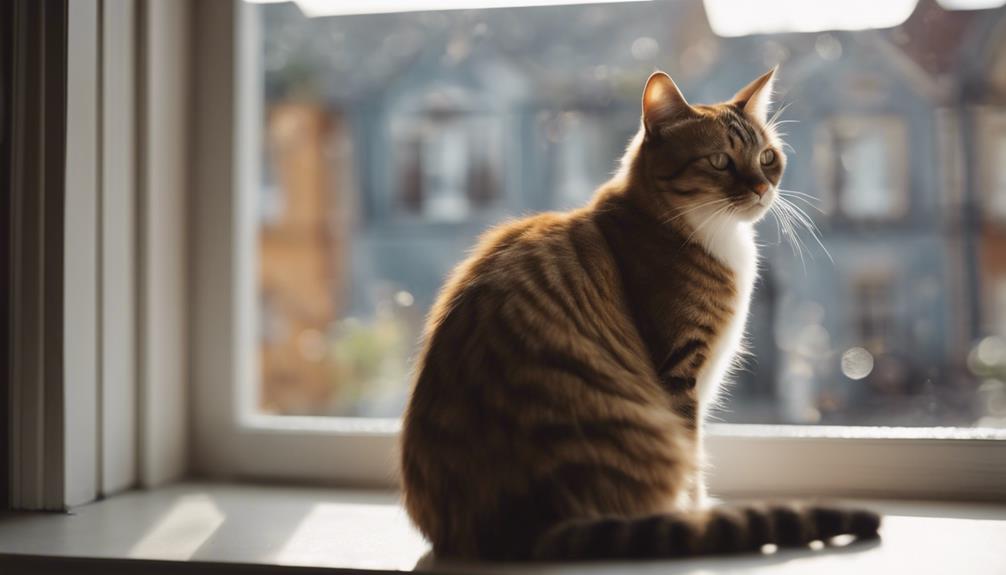
Socializing your cat is an important aspect of their overall well-being and happiness. It is recommended to socialize your cat on a daily basis to help build a strong bond with them. This can include playing with them, petting them, and engaging in interactive activities. Regular socialization can also help prevent behavioral issues and build their confidence. Each cat is different, so it is important to pay attention to their individual needs and preferences when socializing them. Remember to always approach your cat with patience and respect to ensure a positive socialization experience.
By dedicating time each day to socialize your cat, you can strengthen your relationship with them and provide them with the love and attention they need to thrive.
Importance of Socializing Your Cat
Socializing your cat is crucial for fostering positive behaviors, ensuring their well-being, and strengthening the human-animal bond. The benefits of socialization can't be overstated; it helps cats feel more secure, reduces anxiety, and prevents behavioral issues like aggression or excessive shyness. By exposing cats to different people, animals, and environments early on, they learn to adapt and become more confident in various situations.
However, there are some drawbacks to consider. Improper socialization or lack thereof can lead to fearfulness, stress, and even health problems in cats. It's essential to approach socialization with care and patience, respecting the cat's boundaries and comfort levels.
When it comes to socialization techniques and tips, gradual exposure is key. Start by introducing your cat to one new person or animal at a time in a quiet, controlled environment. Use positive reinforcement such as treats or toys to associate these interactions with pleasant experiences. Consistency, patience, and respect for your cat's individual personality are essential components of successful socialization.
Factors to Consider for Socialization
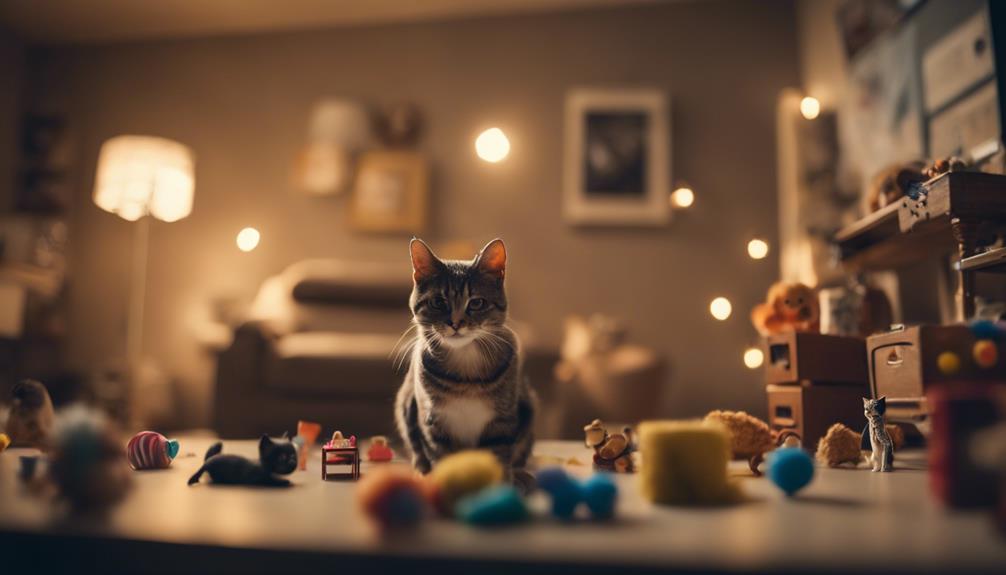
When considering socialization for your cat, it's important to take into account various factors that can influence the process and outcome of their interactions with people, animals, and environments. Socialization challenges may arise from past traumas, fear, or lack of exposure to different stimuli. To address these challenges, pet owners can employ various strategies such as gradual exposure, positive reinforcement, and creating a safe environment for their feline companions to explore. Understanding a cat's body language and behavioral cues can help in identifying when they're feeling stressed or overwhelmed during socialization attempts, allowing for adjustments to be made to ensure a positive experience.
Behavior modification techniques can also play a crucial role in facilitating successful socialization. These techniques involve rewarding desirable behaviors, implementing desensitization exercises, and seeking professional guidance when needed. Patience, consistency, and empathy are key components when working on socializing a cat, as each feline may respond differently to socialization efforts. By considering these factors and implementing appropriate strategies, pet owners can help their cats become more comfortable and confident in various social situations.
Early Socialization for Kittens
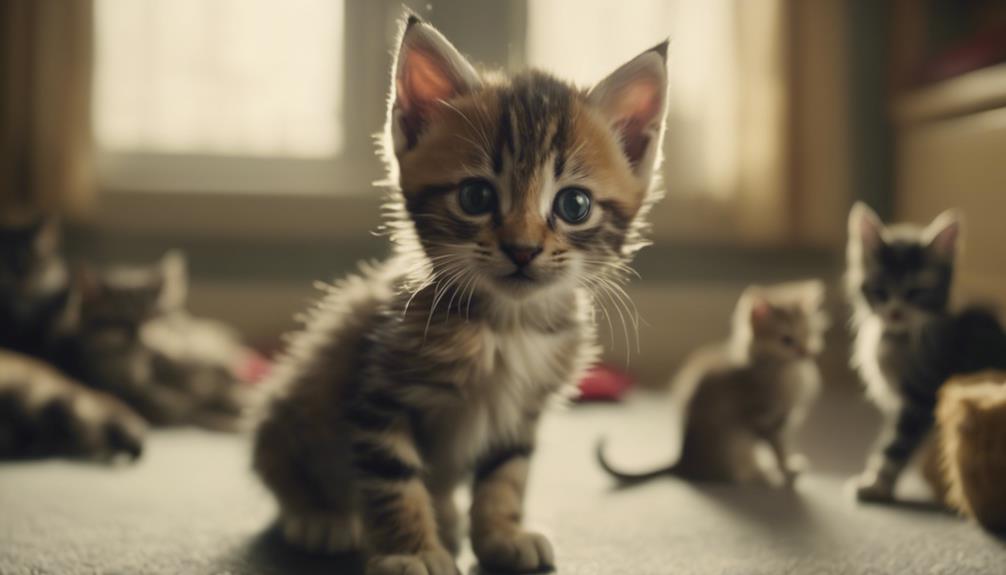
Early socialization plays a crucial role in shaping the behavior and temperament of kittens. This period, typically occurring between 2 to 9 weeks of age, is vital for fostering positive interactions and adapting to various stimuli.
Here are three key aspects to consider when focusing on early socialization for kittens:
- Kitten Playdates: Introducing kittens to their littermates or other well-socialized cats can help them learn appropriate social behaviors through play and interaction. These experiences can lay the foundation for healthy social skills in adulthood.
- Socialization Techniques: Utilizing gentle handling, exposing kittens to different environments, sounds, and textures, and providing positive reinforcement during interactions can help them become more adaptable and confident cats.
- Feline Friendships, Early Bonding: Encouraging kittens to form bonds with humans and other felines early on can lead to the development of strong, lasting relationships. These early friendships can positively impact their social behaviors and overall well-being throughout their lives.
Socializing Adult Cats
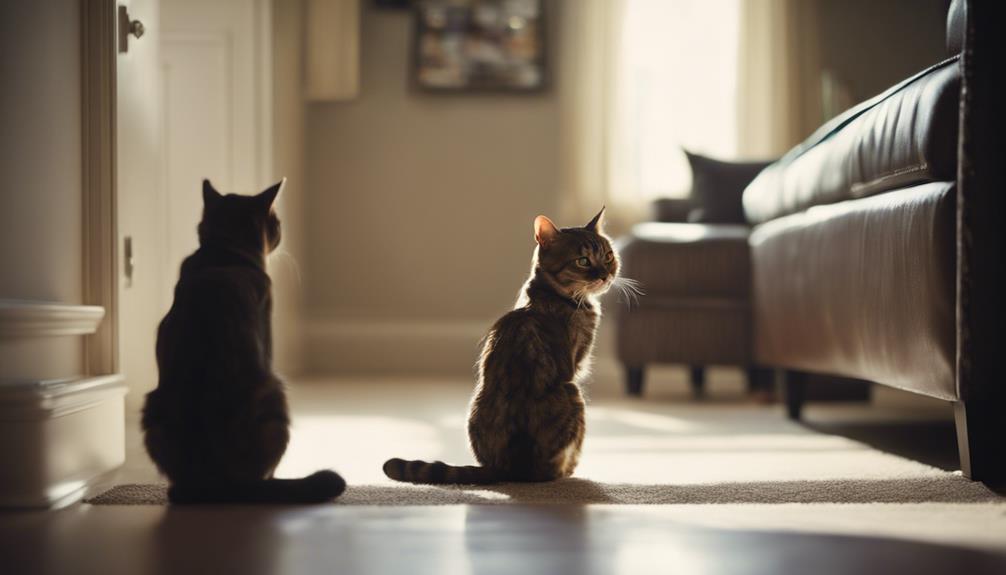
Adult cats benefit greatly from gradual exposure to new environments and positive interactions with humans and other animals. When socializing adult cats, it's essential to approach it with patience and understanding. Unlike kittens, adult cats may have established behaviors and preferences that can influence their socialization process. Introducing them to new situations slowly can help reduce stress and increase their comfort levels.
Group playdates can be an effective way to socialize adult cats, allowing them to interact with other animals in a controlled environment. These interactions can help improve their social skills and reduce any anxiety they may have around unfamiliar animals. However, it's crucial to monitor these interactions closely to ensure that all animals involved are comfortable and safe.
Adult cats may also present behavioral challenges during the socialization process. Some cats may exhibit fear, aggression, or avoidance behaviors when introduced to new environments or individuals. Understanding these behaviors and addressing them with positive reinforcement and patience can help adult cats overcome their socialization barriers. By providing a supportive and nurturing environment, adult cats can gradually learn to socialize and form positive relationships with others.
Frequency of Socialization Sessions
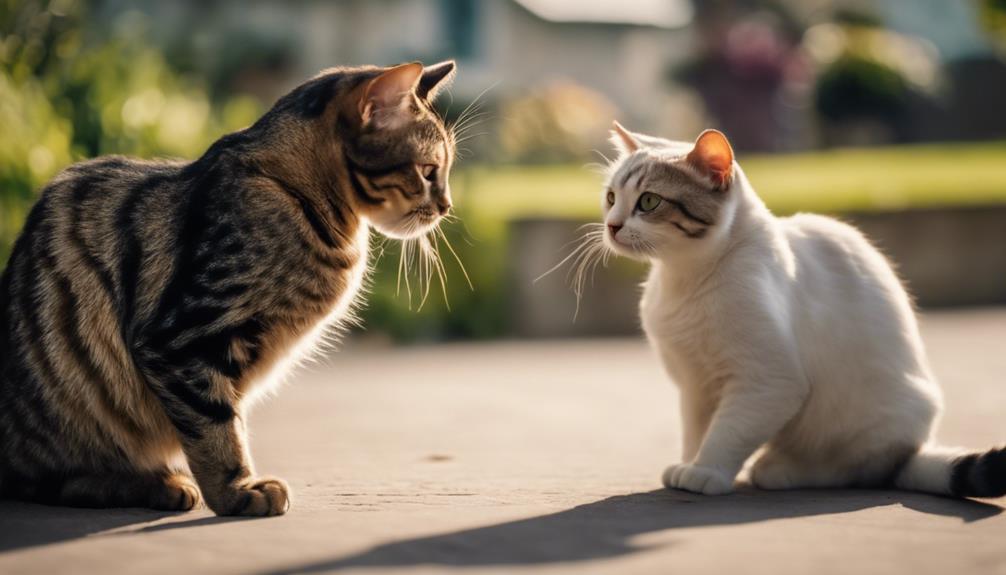
When considering the frequency of socialization sessions for cats, it's essential to take into account the duration of each session.
Short, regular interactions can be more effective than infrequent, lengthy sessions.
Additionally, monitoring the cat's comfort level during these sessions is crucial for successful socialization.
Socialization Session Duration
For optimal socialization, cat owners should aim to incorporate daily socialization sessions into their pet's routine. Here are some essential points to consider for the duration of these sessions:
- Balanced Approach: Keep socialization sessions short initially to respect the cat's boundaries and gradually increase the duration as the cat becomes more comfortable.
- Regular Breaks: Incorporate breaks in between socialization techniques to allow the cat time to relax and process the interactions.
- Interaction Duration: Pay close attention to the cat's body language and cues during socialization sessions; if signs of stress or discomfort are observed, end the session promptly to respect the cat's comfort level.
Cat's Comfort Level
To ensure optimal socialization for your cat, it's important to gauge their comfort level and adjust the frequency of socialization sessions accordingly. Respect your cat's comfort boundaries by observing their body language and reactions during interactions.
Some cats may require more trust building before increasing the frequency of socialization sessions. Implement various socialization techniques to make the experience positive for your cat, such as using treats or toys to encourage interaction. Gradually increase the interaction frequency based on your cat's response, always prioritizing their comfort and well-being.
Signs of Overwhelming Socialization
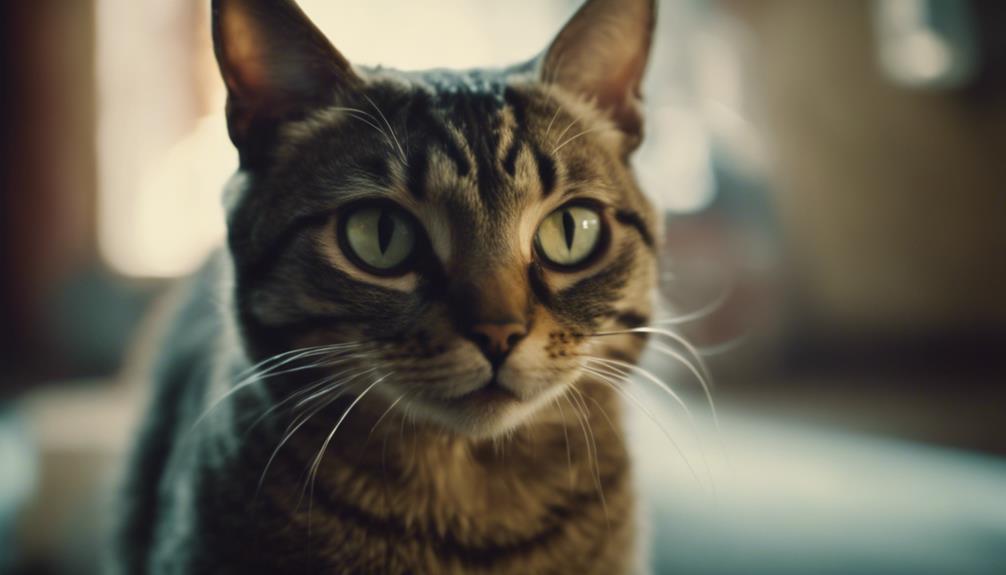
Cats have limits when it comes to socialization, and exceeding these boundaries can lead to overwhelming stress for the animal. Recognizing a cat's stress indicators is crucial in determining when socialization sessions may be too much for them.
If a cat shows signs of being overwhelmed, it's essential to give them a break from social interactions to prevent further stress.
Socialization Limits for Cats
Excessive socialization in cats can lead to signs of stress and anxiety that indicate a need to adjust the level of interaction. It's crucial to be mindful of a cat's boundaries to ensure their well-being.
Here are three signs that may indicate overwhelming socialization for your feline friend:
- Increased Hiding: If your cat starts hiding more frequently or in unusual spots, it could be a sign of feeling overwhelmed.
- Aggression: Uncharacteristic aggression towards people or other animals may suggest that your cat is struggling with too much social interaction.
- Excessive Grooming: Cats may resort to excessive grooming as a coping mechanism when they're stressed, indicating a need to reduce socialization efforts.
Always observe your cat's behavior to respect their socialization boundaries.
Cat's Stress Indicators
Watching for behavioral cues is essential in recognizing when a cat is experiencing overwhelming socialization. Recognizing stress in cats can be crucial for their well-being. Signs of stress include excessive hiding, aggressive behavior, excessive grooming, loss of appetite, or excessive meowing.
If a cat shows these signs during socialization, it's essential to manage their anxiety effectively. Providing a safe space where the cat can retreat to is important. Additionally, using calming pheromone diffusers or treats can help alleviate their stress. Understanding and respecting a cat's limits is key to successful socialization.
Socialization Break Time
Recognizing signs of overwhelming socialization in cats is crucial for ensuring their well-being and adjusting the socialization process appropriately. To prevent stress and maintain mental health during the socialization routine, here are key indicators that your cat may need a break:
- Increased Hiding: If your cat starts hiding more frequently or in unusual spots, it could be a sign of feeling overwhelmed.
- Aggression: Uncharacteristic aggression towards humans or other animals may indicate that the socialization routine needs to be adjusted.
- Excessive Vocalization: Cats may meow excessively when feeling stressed or overwhelmed, signaling a potential need for a socialization break.
Adjusting Socialization Strategies
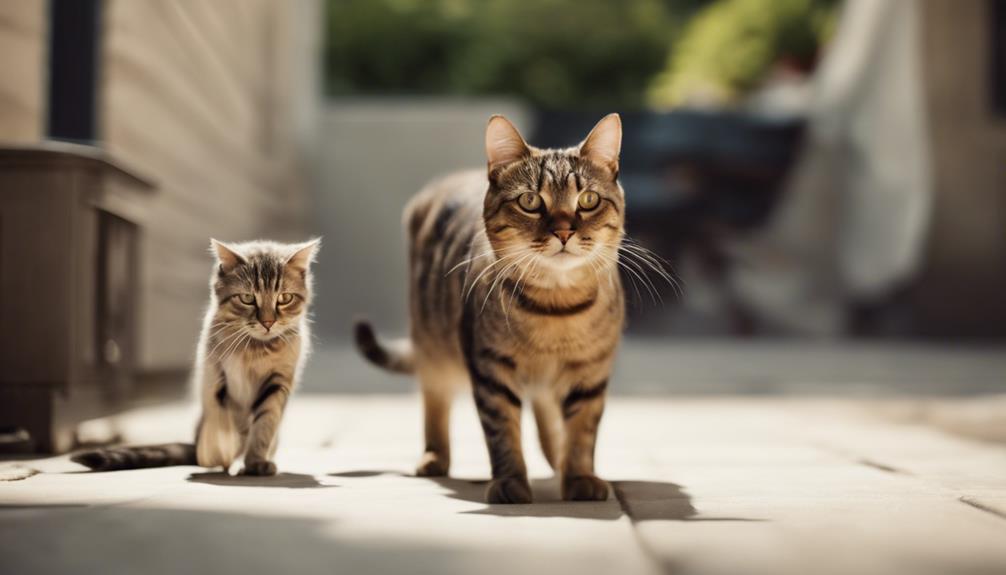
Adjusting socialization strategies for your cat involves observing their behavior in various social situations and adapting your approach accordingly. When implementing socialization techniques, it's crucial to progress gradually, allowing your cat to acclimate at their own pace. Behavioral changes should be monitored closely, and positive reinforcement used to encourage desired behaviors.
If your cat appears anxious or displays signs of stress during socialization attempts, it's essential to take a step back and reassess your approach. This could involve reducing the frequency of social interactions, providing more hiding spots or safe spaces, or introducing new stimuli more slowly. By recognizing your cat's comfort levels and adjusting your strategies accordingly, you can help build their confidence and ease any apprehensions they may have about socializing with others.
Frequently Asked Questions
Can Cats Be Too Old to Benefit From Socialization With Others?
Senior cats can benefit from socialization regardless of age. While they may take longer to adjust, the positive impacts on their mental and physical health make the effort worthwhile. Socialization knows no age limits.
Are There Certain Breeds of Cats That Are More Likely to Struggle With Socialization?
Certain cat breeds, like Siamese and Persians, may face challenges in socialization due to their strong personalities. Understanding breed tendencies can help anticipate potential failures and tailor socialization methods for success, fostering positive interactions with others.
How Can I Tell if My Cat Is Enjoying the Socialization Process or if They Are Just Tolerating It?
Observing a cat's body language and cues during play and interactions is key to determining if they enjoy socialization. Signs of enjoyment include relaxed posture, purring, and initiating contact. If they seem stressed or avoidant, it's best to give them space.
Are There Any Specific Activities or Games That Can Help With Socializing a Cat?
Engaging in interactive toys or training games can enhance a cat's socialization. Enrichment activities and bonding exercises strengthen the human-feline relationship. These activities promote mental stimulation, physical health, and emotional well-being in cats, fostering a deeper connection with their humans.
Is It Possible to Socialize a Cat Too Much, Leading to Behavioral Issues?
Over socialization risks can lead to behavioral issues in cats. Pushing too much interaction may cause stress, anxiety, and aggression. It's important to find a balance in socializing to ensure a positive and comfortable experience for the cat.










